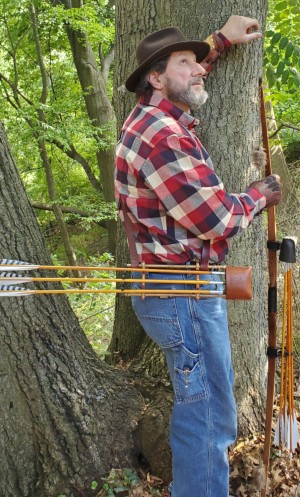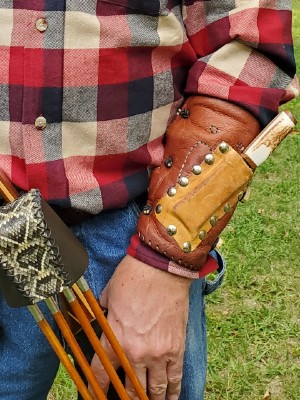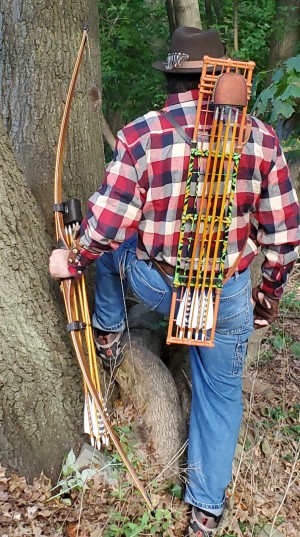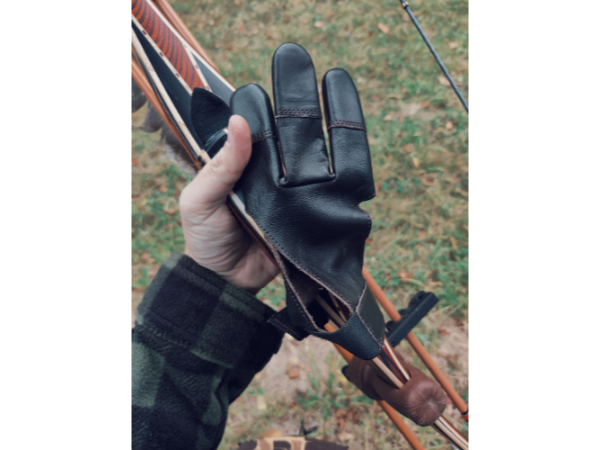I didn’t really start out trying to invent a new quiver. It basically happened by watching two of my archer friends practicing with their bows. They were very new to the sport and I take credit for getting them involved in archery. Both of them were actually pretty good at hitting their intended targets. They both kept their shots from five to eighteen yards apiece. I was really impressed how good they both were. They took to the sport like ticks to a deer. Their accuracy was spot on. They were putting six arrows apiece in paper pie plates that were attached to straw bales. Life was good.
I also introduced them to a couple of fine archery catalogs containing numerous paraphernalia that we all need, or should I say must have. The boys quickly noticed the beautiful bow quivers that were offered, and they immediately purchased two very fine side mounted bow quivers.

“GFA” style over-the-shoulder quiver made—”reinvented”—from a Great Northern Bow quiver that once attached to the bow’s riser.
They couldn’t wait to shoot their recurves with the new bow quivers attached. I was just as excited for them. With new quivers attached, we headed to the practice range. What happened next was frightening. Their arrows were flying everywhere but at the pie plates. Fifteen inches high, twelve inches left and right, two inches low! Inexcusable! Stop the world and let me off! What the heck was happening here? I asked if I could shoot both of their bows. I put all twelve arrows at fifteen yards in the twelve-inch pie plate. Hmm…. Nothing wrong with the equipment.
Come to find out, neither of these guys was able to shoot their bows accurately with a bow mounted quiver. In their mind’s eye it appeared that something was growing off the side of their bow! They couldn’t keep their mind from thinking about the additional piece of equipment that was invading their thought process. As per Fred Anderson, the moral is, it is very simple, just because you have a side mounted quiver on your bow doesn’t mean all is well with your accuracy.
I asked them if they just couldn’t forget about the quivers and just concentrate on the targets. It didn’t help. It was kind of like knowing that you saw a rattlesnake crawl into your tent but couldn’t find it to chase it away, and then realizing that you’ll have to turn in by nightfall…at some time you’ll have to get into your sleeping bag! They had a very hard time concentrating.
To make this story short, all I eventually did was reconstruct their bow quivers to one that resembles a GFA type quiver (that’s for the G. Fred Asbell style quiver). A quiver that can now hang off the side of your body for easy access to your broadhead-tipped arrows.
The other quiver resembles something primitive, maybe a Pueblo/Mesa Indian style back quiver. For the Asbell style quiver I used all broken arrows for the standard frame (not my broken arrows, I never missed, not once, Hmmmmm). For the back ‘style’ quiver I used 3/8 inch wood dowels. I then laced very thin, fine dowels that I interwove throughout the larger frame. Granted, there are individuals out there who probably couldn’t get used to wearing back quivers, or any other style of quiver that hangs from the shoulder. The two quivers that I’m showing in this article are not the only solutions to carrying your arrows. These two guys just spent their hard-earned money on equipment that was not working for them. They were not comfortable nor able to adjust their ability to concentrate without noticing the appendages protruding off their recurves. Psychological? You bet! Incurable? Maybe!

A closer look at the homemade T.J. Conrads style ‘improvised’ armguard.
To reinvent, or more likely manipulate these boys’ quivers made it possible for them to go back to the practice range and do what they did best, and that was to efficiently put their arrows all back into the pie plate targets. With a little ingenuity, you too can reinvent some old discarded gear or clothing that will better suit your needs.
On the front of his book, The Traditional Bowhunter’s Handbook, I saw a picture of T.J. Conrads with a very cool looking armguard that had a knife attached to it. Well, I just thought that was one of the coolest armguards I had ever seen. So, I took one of my own and fashioned a sheath with a Scottish dirk and applied it to my armguard. At every 3-D shoot, rendezvous or archery gathering there are at least ten people that tell me how cool it is. Simple to do? You bet!
Our sport is a great sport. All you have to do is turn to the great archers past and present and you’ll notice something about them that will one day catch your eye. I’m never afraid to call these guys or gals my heroes, because that’s exactly what they are to me.
I really like a lot of things that T.B.M. contributor Krista Holbrook makes. She and her husband, Sterling, are the real deal. You have to be able to thank somebody wholeheartedly for showing other people in our sport how to take discarded items and turn them into real gems that are now functional and useful.
So, before you lay down your hard-earned cash for some nice archery accessories, try to borrow these items and ideas from friends or fellow archery club shooters or enthusiasts, and then you too will also be known as a Reinventor!
- Mesa/Pueblo pack frame style back quiver made from a Selway slide-on bow mounted quiver hood.
- Mesa/Pueblo pack frame quiver in the deer woods in action. Notice the Selway slide-on bow limb broadhead ‘cowl’ that was reinvented to be a back quiver.
- Homemade sheath attached to arm guard with Scottish “dirk” inserted. All my armguards are now padded with faux lambswool to sop up sweat from my arm on a hot summer day.









What about making the “GFA” convertible, both a shoulder and a back quiver.I haven’t worked all the details, since I’ve just read this.but I think an extra strap that’s attached
under the armpit.
OOPS and with the arrows pointing down.